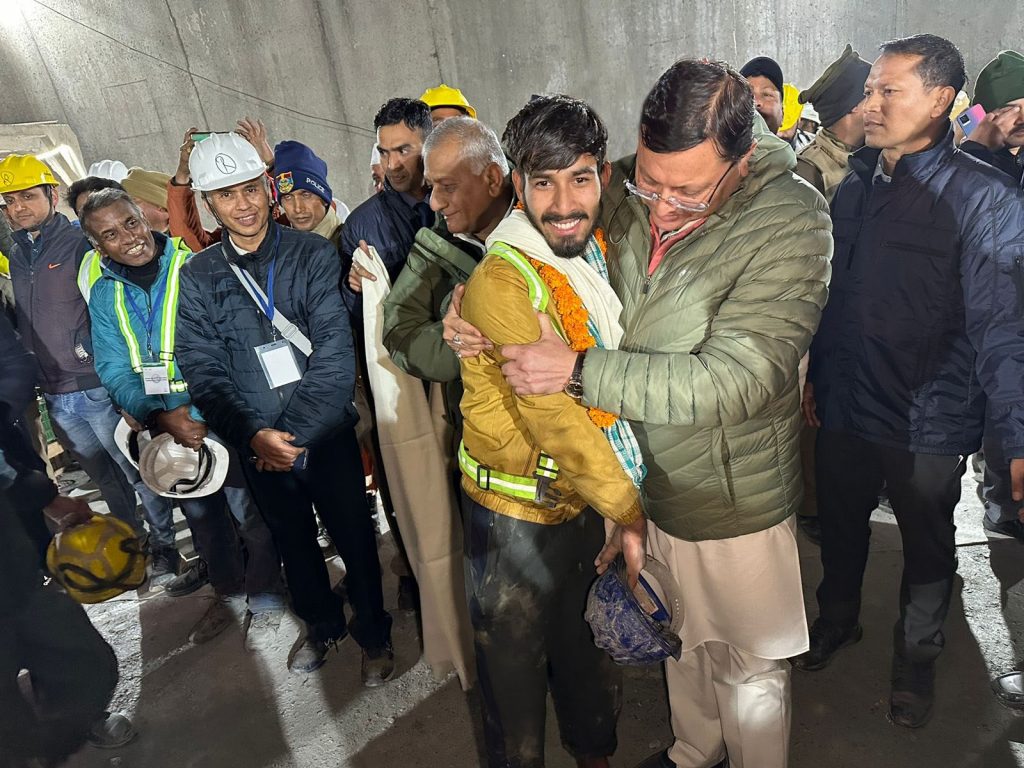
It is a triumph of human labour over machinery. The gritty tale of 41 rescued workers who told the PM Modi that “not once in 17 days did we feel weak or fearful.” PM hailed the resilience of workers and observed, “You are an inspiration for the country.” A report by Sunny Sharma
However, the Uttarkashi accident involving the trapped workers at Silkyara, is a wake-up call. The government must investigate what is wrong with occupational safety and health framework for workers. The workers in this case had entered at 8 pm on November 11, eager to work through the night, so that Diwali could be celebrated the next day on November 12. But at 5.30 the next morning, the tunnel around them rumbled, the debris continued to fall, completely blocking their exit.
They scrambled at first, but their experience told them to stand back and the next 17 days, these 41 were trapped in the Silkyara-Barkot tunnel in Uttarkashi. They stayed together as rescuers outside went through one technique after another to find a way out. At 7.45 pm on November 29, they finally came out finding light at the end of the tunnel. In between, it was the 4-inch pipe that became their first lifeline. Within the first two days, oxygen and dry food began arriving in packets through the pipe but very few could eat. Oxygen was important, because some of them started facing breathing problems. However oxygen was pumped in through a small pipeline subsequently.
The entire nation has heaved a sigh of relief as all the 41 workers have been safely pulled out and the credit goes to the members of the Central and state teams, to the international tunnelling expert Arnold Dix, who oversaw the evacuation exercise.
Amid the nationwide euphoria over a job well done, some questions need to be asked: What led to the partial collapse of the under-construction tunnel? Were ecological norms bypassed before or during the execution of the project? Were steps taken to ensure that the work did not disturb the stability of the slopes?
A thorough probe is needed to ascertain the laxity and negligence that imperilled the lives of the workers. The incident has brought under scrutiny various projects in progress under the Char Dham programme. The Silkyara-Barkot tunnel is part of the ambitious Char Dham Pariyojana, under which several highways and roads are being constructed and widened in Uttarakhand. Safer working conditions are also necessary for the personnel carrying out road-widening and related work.
Lessons should be learnt promptly from the Silkyara nightmare and there must be no delay in initiating remedial action. The Char Dham Project involves large-scale construction in one of the most ecologically fragile zones in the world — the Himalayas.
While connectivity and development are essential to the region, how these projects are being undertaken may require a closer look, especially in terms of increasing the focus on sustainability and environmental clearances.
Earlier incidents at Tehri dam should have alerted the government. The rescue operation can also serve as a blueprint for future natural disasters and accidents. Finally, the Uttarkashi tunnel collapse has once again turned the spotlight on the invisible migrant workers – the last time they drew the nation’s attention was because of their travails during the lockdown in the pandemic. From those trapped to those who rescued them, are arduous stories of being away from home, amid unsafe working conditions and a precarity of existence that mostly goes unrecognised. A review of the precautionary measures, especially in ecologically sensitive zones, is a must to prevent such mishaps.













